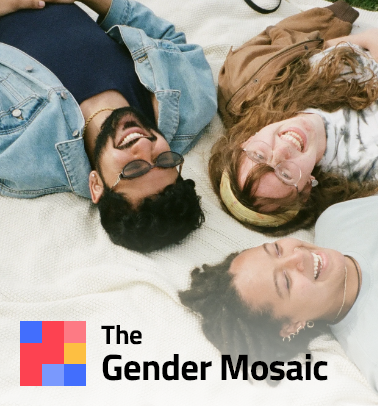

Gender Mosaic / Prof. Daphna Joel
Gender Mosaic / Prof. Daphna Joel
You surely know that women and men differ, on average, in certain ways – in the way they behave, and in what they prefer to do for a living or in their spare time. There are also differences, typically much smaller ones, in the cognitive and emotional abilities of women and men, and girls and boys (more about this in Gender Differences in Psychology). You, yourself, may be aware of having certain feminine characteristics (that is, those that are more common in women compared to men) and certain masculine ones. But did you know that all human beings probably have a mix of traits, each person having them in a unique combination?
Researchers who launched the first modern studies into masculinity and femininity in the first half of the 20th century assumed that there existed distinct personalities – one characteristic of men and another, of women. In reality, already back then, their studies found that people could be masculine on some sub-scales – for instance, those covering hobbies, interests or reading preferences – and feminine on others – for example, general knowledge, personality characteristics or attitudes. These results were ignored, however, in favor of the view that women and men are aligned along a femininity-masculinity continuum.
In the 1990’s, American psychologist Janet Spence rediscovered the idea that “men and women do not exhibit all of the attributes, interests, attitudes, roles and behaviors expected of their sex according to their society’s descriptive and prescriptive stereotypes but only some of them. They may also display some of the characteristics and behaviors associated with the other sex.” (Spence, 1993) Studies by other researchers provided further support for this idea, showing that two variables on which women and men differ significantly, on average, are not necessarily well correlated. For example, if a woman scored high on empathizing (the ability to understand how someone else feels, on which women score on average higher compared to men), this didn’t necessarily mean that she scored low on systemizing (the drive to analyze or construct systems, which is more common in men). Another such pair was interest in people and interest in things. Researchers often stress the large difference between women and men on these preferences but rarely discuss the low correlation between the two – that is, the fact that people may, for example, show a high interest in both people and things, or a low interest in both.
Finally, in 2015, my colleagues and I conducted a large study that analyzed the behaviors, preferences and attitudes of over 5,500 individuals from three datasets. We analyzed only variables that showed a large difference between women and men. For each of these variables, we defined a range of ‘feminine’ scores – that is, those that were more common in women than in men (pink in the figure below), a range of masculine scores (blue), and a neutral range, that is, scores similarly common in women and men (white). With these definitions we found very few people who had only feminine or only masculine characteristics. The vast majority were “mosaics” – each had her or his own unique mosaic of feminine, masculine and neutral characteristics (see the table below). (Mosaicism is also characteristic of the human brain. Read more about the brain mosaic here).
Our 2015 study was conducted with three datasets of American youth. Our new dataset, which is still being gathered using the Gender Mosaic Questionnaire, includes a much larger and more diverse sample, in terms of country of origin, age, religiosity level, and sexual orientation. Preliminary analyses suggest that mosaicism is prevalent in this dataset as well.
So gender characteristics rarely appear in an individual as a set of only feminine or only masculine features. Why then do we perceive humans as belonging to one of two distinct sets and fail to see their unique mosaic of characteristics? The short answer is that this happens because our society is structured around the assumption that gender is binary, that is, that individuals have either a set of feminine or a set of masculine characteristics.
This assumption is most often implicit, as in the invitation by a nursery teacher: “Girls, come listen to a story, boys – go play outside with a ball.” There may indeed be gender differences in these activity preferences (with more girls than boys preferring to listen to a story, and the reverse being true for playing ball), but kids don’t belong to two types: those who love stories but not balls, and those who love balls but not stories. There are also kids who love playing ball and listening to stories, and those who like neither.
These are two activity preferences, and they give rise to four different combinations. If we consider more activities, each with its own gender difference, the number of possible gender mosaics is enormous. (You can check out your own by taking the Gender Mosaic Questionnaire). Yet, as a result of the binary gender system, we perceive and treat others as if they belonged to one of two types, instead of appreciating their own unique mosaic of characteristics.
You can read more about the psychological mechanisms that lead us to overlook the mosaics of others and perceive them instead as either women or men, in Gender Mosaic: Beyond the Myth of the Male and Female Brain.




